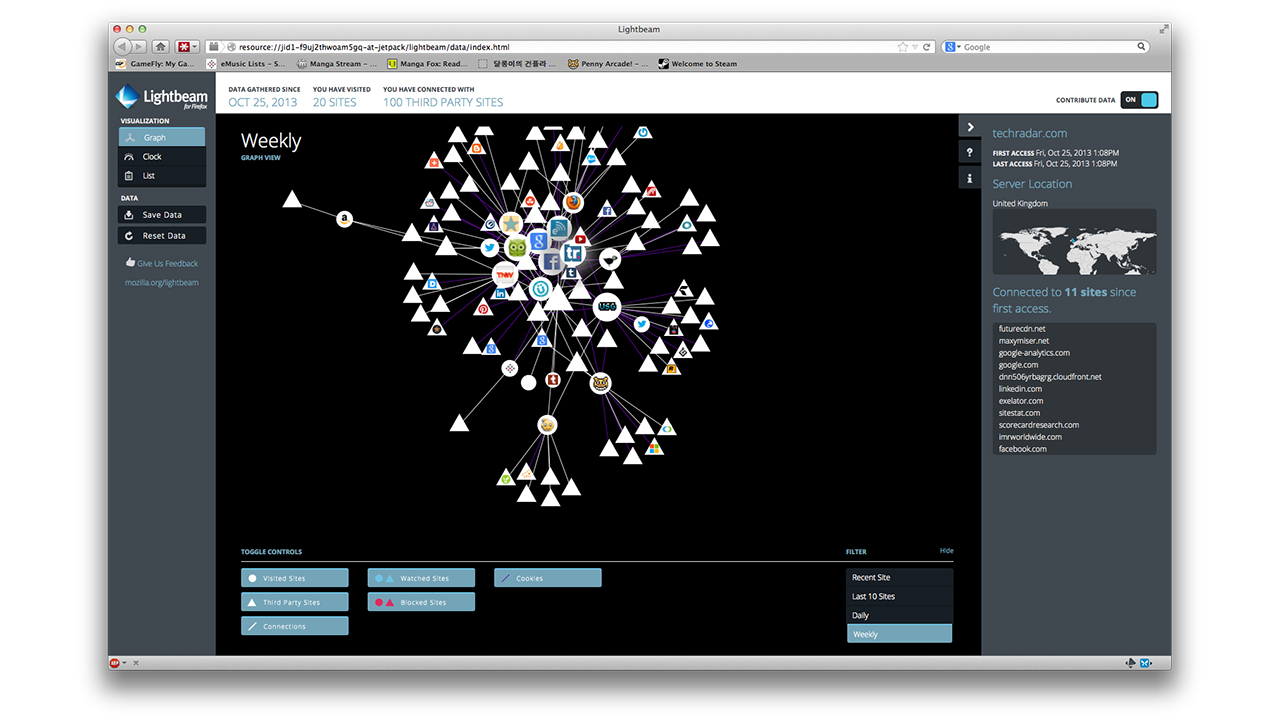Lightbeam is a Firefox add-on that enables you to see the first and third party sites you interact with on the Web. Using interactive visualizations, Lightbeam shows you the relationships between these third parties and the sites you visit. Lightbeam for Firefox is developed with support from the Ford Foundation and the Natural Sciences and Engineering Research Council, as well as faculty and students from the Emily Carr University. Lightbeam is a Firefox add-on that enables you to see the first and third party sites you interact with on the Web. Using interactive visualizations, Lightbeam shows you the relationships between these third parties and the sites you visit. Lightbeam for Firefox:: Tools Lightbeam is a Firefox add-on that enables you to see the first and third party sites you interact with on the Web. Using interactive visualizations, Lightbeam shows you the relationships between these third parties and the sites you visit.
An email from Mozilla about Lightbeam for Firefox said,
We built Lightbeam to shine a spotlight on online data tracking to help people understand the Web. After you download and install the Lightbeam add-on to Firefox, it creates a real-time visualization of the websites you visit and all the third parties active on those sites. As you browse from site to site you can watch the visualization grow. You can also share your Lightbeam data with Mozilla and better inform a global dialog on the prevalence of tracking.

I'm not particularly interested in sharing my data with Mozilla – they probably know everything there is to know about me already without giving them more – but I was interested in seeing how this worked and what kind of privacy insights it offered.

The graph at the top of the post shows Lightbeam after being installed in Firefox for only one day. The circles are sites I visited, the triangles are 'third party site' connected to the sites I visited. In one day after installing Lightbeam, I visited 11 sites and was connected to 117 third party sites.
On the graph view, if you hover over any one of the circles or triangles, you can see what it is. You can manipulate the display. For example, here is the graph with third party sites dimmed out.

Dragging (like on a Google map) will zoom in or out of the graph so you can look at the data in various closer or more meta ways. The controls under the display help you choose what you want to examine more closely.
The Cookies filter identifies when a site has stored some data in your browser. You can set site preferences and the graph will identify sites that are blocked or watched.
Firefox Lightbeam For Chrome
The data can be viewed as a clock (not shown) and as a list, which you can see here.
Next I visited this blog. Clicking on anything in the graph gives you more information. Here's the graph with the little WT icon for Web Teacher selected. A sidebar opens with all kinds of data about the site.
Some of the sites this blog is connected to are obvious from the content, ads and various sharing icons: youtube, gravatar, twitter, blogherads, addthis. Further down the list of 33 sites linking from Web Teacher, I found names I never heard of and didn't know how they got there. I suspect they come from something related to the ads, but I really don't know for sure. And this is my blog!
Light Beam For Firefox


I'm not particularly interested in sharing my data with Mozilla – they probably know everything there is to know about me already without giving them more – but I was interested in seeing how this worked and what kind of privacy insights it offered.
The graph at the top of the post shows Lightbeam after being installed in Firefox for only one day. The circles are sites I visited, the triangles are 'third party site' connected to the sites I visited. In one day after installing Lightbeam, I visited 11 sites and was connected to 117 third party sites.
On the graph view, if you hover over any one of the circles or triangles, you can see what it is. You can manipulate the display. For example, here is the graph with third party sites dimmed out.
Dragging (like on a Google map) will zoom in or out of the graph so you can look at the data in various closer or more meta ways. The controls under the display help you choose what you want to examine more closely.
The Cookies filter identifies when a site has stored some data in your browser. You can set site preferences and the graph will identify sites that are blocked or watched.
Firefox Lightbeam For Chrome
The data can be viewed as a clock (not shown) and as a list, which you can see here.
Next I visited this blog. Clicking on anything in the graph gives you more information. Here's the graph with the little WT icon for Web Teacher selected. A sidebar opens with all kinds of data about the site.
Some of the sites this blog is connected to are obvious from the content, ads and various sharing icons: youtube, gravatar, twitter, blogherads, addthis. Further down the list of 33 sites linking from Web Teacher, I found names I never heard of and didn't know how they got there. I suspect they come from something related to the ads, but I really don't know for sure. And this is my blog!
Light Beam For Firefox
Lightbeam Add-on For Firefox
LIghtbeam is an eye-opener. It gives me the ability to block sites, but beyond that I don't see many opportunities for actions to improve my privacy I can take using this addon. Am I missing something important Lightbeam offers me as an individual user? Twixtor pro mac. Is it just part of big data collection about me?
